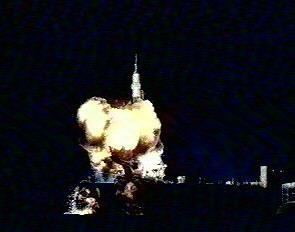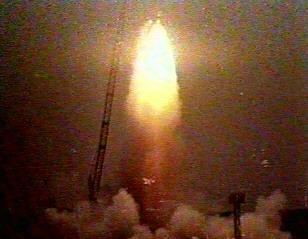
Praskovya Mikhailovna Strekalova did not want her son to fly into space. It was not just the fact that 43-year-old Gennadi Strekalov would be sitting atop thousands of pounds of volatile propellants, about to be blasted off the planet, but there was something inexplicable about her words of warning. Even though he had flown twice before, Mrs. Strekalova had an uncanny feeling that this one—his third—would end unhappily. In April 1983, her son had flown aboard Soyuz T-8 and his crew had returned to Earth after two days, having failed to dock with the Salyut 7 space station. Now, she was convinced that Strekalov’s launch would be a bad one. How right she was, for 26 September 1983—30 years ago this week—her son came within a whisker of losing his life in what has been described as “almost” Russia’s Challenger.
It has always been known that launch, and the final minutes before launch, is perhaps the most dangerous phase of any mission. Unmanned rockets exploded with alarming frequency in the early days of the space program, and in April 1975 the Soyuz 18A launch vehicle malfunctioned during ascent and sent its cosmonaut crew on a hair-raising suborbital flight, touching down in the harsh wilderness of Siberia. However, with a veteran spacecraft and rocket, the flight of Soyuz T-10 was anticipated with confidence. “As the prospective 94th manned space launch to orbit, the ascent was not expected to be an outstanding event in space history,” wrote space historians Rex Hall and Dave Shayler in their book Soyuz: A Universal Spacecraft. “However, what transpired was a ‘first’ which both cosmonauts would no doubt have gladly foregone.”
It was late in the evening of 26 September 1983 when the Soyuz T-10 crew of Commander Vladimir Titov and Flight Engineer Strekalov boarded their spacecraft and took their seats in the descent module. Launch was scheduled for 10:38 p.m. Moscow Time, and, after docking with Salyut 7, the newcomers would spend about a month with the incumbent Soyuz T-9 crew of Vladmir Lyakhov and Aleksandr Aleksandrov, performing several spacewalks to install and deploy additional solar arrays—a task for which they had specifically trained—before the outgoing cosmonauts departed. Titov and Strekalov would then settle down for an anticipated three-month mission, which space historian Phillip Clark expected to end during a Salyut “landing window” in late December 1983 or early January 1984.

At the desolate Baikonur Cosmodrome in today’s independent Kazakhstan—then one of the former satellite states of the Soviet Union—preparations for the nighttime liftoff proceeded seemingly without incident. Two minutes before the rocket was due to go, the first signs of trouble began to brew. Temperatures at the pad had fallen from around 27° C during the day to just 10° C that night, with winds gusting at upwards of 25 mph. Inside the cabin of their Soyuz capsule, Titov and Strekalov listened to music, piped in through the communications system, as they executed their final systems checks and verified the integrity of their Sokol launch and entry suits.
Ninety seconds to go …
All at once, a fuel valve—charged with supplying the strap-on tapering boosters of the rocket’s first stage—failed to close properly. As a consequence, raw propellant spewed across the surface of the launch pad and, within a minute, caught fire. The blaze spread with alarming rapidity, licking the sides of the rocket. As well as being fully laden with highly explosive propellants, the vehicle’s separation pyrotechnics were armed and its engines just seconds away from ignition. At the blockhouse, a few miles away, Launch Director Alexei Shumilin watched with mounting horror as the ferocious pace of the fire increased.
For their part, Titov and Strekalov had no windows to witness the progress of the fire, but they were quickly aware of what was going on. The strange sounds emanating from the rocket convinced Strekalov that something was not right and he tightened his harness, telling Titov to do the same. They could clearly hear urgent chatter from launch controllers over the communications loop. This urgency was intensified when it became clear that the raging inferno had burned through the wiring which should have triggered the rocket’s escape system to fire, yanking the Soyuz T-10 orbital and descent modules away from the burning booster and parachuting them a few miles to safety. Titov and Strekalov had no controls in the descent module to permit them to manually activate the escape system. The only chance to override it was to use a backup radio command … but that required a pair of controllers, located in different rooms in a different building more than 20 miles from the pad, to press their buttons within five seconds of one another.Not only that, but in order for them to be in a position to do this, they each had to receive a code word (“Dnestr”), independently, from both Shumilin and the rocket’s technical leader, a man named Soldatenkov. By the time all of these steps had been concluded, 10 seconds had elapsed and Titov and Strekalov’s booster was literally engulfed in flames and dangerously close to an explosion.
Within seconds of the command from Shumilin and Soldatenkov, the pyrotechnics fired and the escape tower’s powerful solid rocket engines—totalling around 176,000 pounds of thrust—rapidly pulled the Soyuz T-10 descent and orbital modules away from the burning booster. The immense velocity and the angle of departure imparted high-G accelerations on the two cosmonauts. After the event, Titov recalled feeling the entire rocket physically swaying, followed by two waves of vibration as the escape tower fired and a sharp jerk as he and Strekalov were boosted to safety. Observers at the blockhouse witnessed an enormous red, yellow, and black cloud surrounding the top of the booster, after which an object could be seen shooting upwards at a high rate of speed. Within seconds, Titov and Strekalov reached a velocity of Mach 1, traveling near-vertically, rose to an altitude of 3,000 feet, and endured peak acceleration loads of between 14-17 G. A mere six seconds after the capsule had been tugged to safety, the booster exploded in a holocaust of flame.
In the blockhouse, images released many years later show a gaggle of uniformed military officers, their backs to the camera, watching the unfolding drama through large picture windows. As the escape tower pulls Soyuz T-10 away from the inferno, one of them nonchalantly rubs his nose.

After this near-disaster, which one official later described as having brought the Soviet human space program to within “six seconds from a Soviet Challenger,” it became clear that the rocket was already beginning to lean precariously, before the escape tower even fired, showing that Titov and Strekalov probably were even nearer to death … and luckier than perhaps any space crew in history. Certainly, some accounts note that the rocket collapsed onto the pad within three or four seconds of the activation of the escape tower. Others relate that it was as little as two seconds.
Whether two or three or four or six, though, is immaterial, for the cosmonauts had escaped oblivion, literally, by the skin of their teeth. Some 2,100 feet above the ground, the orbital and descent modules were automatically separated, dropping free of the escape tower and shroud, and within seconds Titov and Strekalov began a slow fall toward the Kazakh steppe. The descent module’s heat shield was jettisoned, exposing six solid-fuelled landing rockets in the base, and the shaken and badly bruised cosmonauts came to a hard, parachute-assisted touchdown at 10:43 p.m. Moscow Time, 2.4 miles from the blazing launch pad. Their first action after the firing of the escape tower had actually been to switch off their cockpit voice recorder. According to Titov: “We were swearing!”
Half an hour after touching down, the recovery team reached the capsule. The cosmonauts’ first request was for cigarettes, and they were also offered a helpful tumbler of vodka to settle their frayed nerves. The launch pad, meanwhile, continued to burn for no less than 20 hours, before being brought under control and extinguished, and a month later the normally secretive Soviets announced reluctantly that there had been “another accident” in the Soyuz program. Little more was revealed, apart from the successful performance of the escape system and the survival of the two cosmonauts. The mission subsequently became known in the West as “Soyuz T-10A” … and Titov and Strekalov’s misadventure had lasted barely five minutes and 13 seconds.
For years afterwards, the two cosmonauts would remind each other of the events of that fateful night on which they came within seconds of meeting their maker … by referring to 26 September as their second birthday, for it offered them both a new life and another chance and gave them a second opportunity to breathe the fresh air of Earth.
Tomorrow’s article will focus on an earlier Soviet launch abort—the ill-fated flight of Soyuz 18A in April 1975. Today known as “the 5 April Anomaly,” it brought two cosmonauts within a hair’s breadth of meeting their maker.
Want to keep up-to-date with all things space? Be sure to “Like” Retro Space Images & AmericaSpace on Facebook and follow us on Twitter: @AmericaSpace




Worth remembering — good account.
Years later, at an informal ceremony in Houston that I arranged, Titov and Strekalov presented a medal to Max Faget, the inventor of the launch escape tower that had saved their lives. See the photo section of my home page http://www.jamesoberg.com.
That’s very interesting. I’d just assumed that the Soviet-era launch escape system had been fully home-grown.
An excellent summary of the Soyuz T-10. An interesting tidbit is that the escape rocket had 176,000 pounds of thrust. I also remember viewing the video of the military officers watching the incident and was struck how rather unaffected they appeared to be. Looking forward to tomorrow’s report on Soyuz 18A.
After such an experience, there is no doubt that at least “a helpful tumbler of vodka to settle their frayed nerves” was in order. Once again Ben, thank you very much for your excellent work, it is greatly appreciated. Your exceptional research and writing provides a genuine high point in my day.